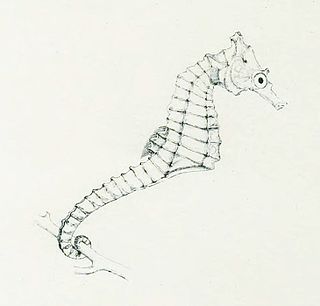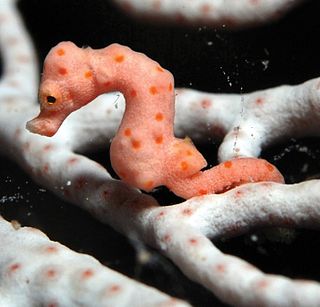
Helen Scales is a British marine biologist, broadcaster, and writer.

Helen Scales is a British marine biologist, broadcaster, and writer.
Helen Scales learnt to scuba dive when she was 16 as part of the Duke of Edinburgh's Award, and from this experience wanted to know more about life underwater. [1]
She studied at St John's College, Cambridge as an undergraduate and holds an M.Sc. in Tropical Coastal Management from the University of Newcastle Upon Tyne. Scales was awarded a Ph.D. from St John's College, Cambridge in 2005; her thesis title was Exploitation of coral reef fish for the live reef fish trade. This was particularly about the humphead wrasse. She was able to identify individual fish through the colour patterns on their heads after filming the fish underwater and so study their movement and behaviour. [2] [1]
Scales worked for several conservation organisations after gaining her doctorate including the World Wide Fund for Nature, TRAFFIC International, the International Union for Conservation of Nature and Natural Resources and Natural England. She was later appointed as a tutor for the University of Cambridge Institute of Continuing Education. Her scientific interests and research focus on marine conservation and the inter-relations between people and oceans, particularly in the context of habitat protection and the international wildlife trade. [2]
Her 2009 book Poseidon's Steed, on seahorses, was described by the reviewer for The Economist as "a fascinating book ... Scales ... explains the myth, biology and ecology of what the Victorians called 'queer fish'." [3] while in National Geographic the reviewer called it "a compelling book about seahorses that makes the case not only for these odd fish but also for the entire ocean." [4]
In October 2011, she appeared on BBC Radio 4's The Museum of Curiosity . Her hypothetical donation to this fictional museum was a tank full of seahorses. [5] In 2013 she spoke at a TEDx event, TEDxLSE, at the London School of Economics. [6] In April 2018, she was a judge for the UK finals of the FameLab competition. [7] In 2021 she was a guest on the BBC Radio 4 programme The Life Scientific. [1]
Scales is the author or co-author of scientific publications and book chapters as well as popular science books and magazine articles. These include:

Sylvia Alice Earle is an American marine biologist, oceanographer, explorer, author, and lecturer. She has been a National Geographic Explorer at Large since 1998. Earle was the first female chief scientist of the U.S. National Oceanic and Atmospheric Administration, and was named by Time Magazine as its first Hero for the Planet in 1998.

Shedd Aquarium is an indoor public aquarium in Chicago. Opened on May 30, 1930, the 5 million US gal aquarium holds about 32,000 animals and is the third largest aquarium in the Western Hemisphere, after the Georgia Aquarium and Monterey Bay Aquarium.

SEA LIFE Sydney Aquarium is a public aquarium in Sydney, Australia. Opened in 1988, it features a large variety of Australian aquatic life, displaying more than 700 species comprising more than 13,000 individual fish and other sea and water creatures from most of Australia's water habitats.

Callum Michael Roberts is a British marine conservation biologist, oceanographer, science communicator, author and research scholar at the University of Exeter. He was formerly at the University of York. He is best known for his research and advocacy related to marine reserves and the environmental impact of fishing.

The big-belly seahorse or pot-bellied seahorse is one of the largest seahorse species in the world, with a length of up to 35 cm (14 in), and is the largest in Australia. Seahorses are members of the family Syngnathidae, and are teleost fishes. They are found in southeast Australia and New Zealand, and are listed on Appendix II of CITES. They are the only species of seahorse found in New Zealand, with a habitat range spanning from the Three Kings Island in the north all the way to the Snares Island in the south.

Hippocampus bargibanti, also known as Bargibant's seahorse or the pygmy seahorse, is a seahorse of the family Syngnathidae found in the central Indo-Pacific area.

The West African seahorse is a species of fish in the family Syngnathidae. It is found in the eastern central Atlantic Ocean off Angola, Benin, Ivory Coast, Gambia, Ghana, Guinea, Liberia, Nigeria, São Tomé and Príncipe, Senegal, and Sierra Leone, as well as the Canary Islands. Although there have been no records from Algeria since Guichenot said that the type was collected at Béjaïa in the 1850s, but the location given may be an error.

Hippocampus angustus, commonly known as the narrow-bellied seahorse, western Australian seahorse, or western spiny seahorse, is a species of marine fish of the family Syngnathidae. It is found in waters off of Australia, from Perth to Hervey Bay, and the southern portion of Papua New Guinea in the Torres Strait. It lives over soft-bottom substrates, adjacent to coral reefs, and on soft corals at depths of 3–63 metres (9.8–206.7 ft). It is expected to feed on small crustaceans, similar to other seahorses. This species is ovoviviparous, with males carrying eggs in a brood pouch before giving birth to live young. This type of seahorse is monogamous in its mating patterns. The males only fertilize one female's eggs for the mating season because of the population distribution. While some seahorses can be polygamous because they are denser in population, this type of seahorse is more sparsely distributed and the cost of reproduction is high. Therefore, the risk to reproduce due to predatory and distributary factors limits this breed to one mate, often finding the same mate season after season.

Barbour's seahorse is a species of fish of the family Syngnathidae.

The Réunion seahorse is a synonym of Hippocampus kuda, Weber, 1913. It is found in Madagascar, Mauritius, Mozambique, Réunion, South Africa, and Tanzania. Its natural habitat is subtidal aquatic beds. It is threatened by habitat loss.

The knobby seahorse, also known as the short-headed seahorse or short-snouted seahorse, is a species of marine fish of the family Syngnathidae. It inhabits coastal waters in southwestern and southeastern Australia, from Gregory to Bremer Bay, and from Denial Bay to Newcastle.

The giraffe seahorse is a species of fish of the family Syngnathidae. It is found in coastal waters off of the south and east coasts of Africa, from South Africa to Tanzania, and possibly north to Kenya. It lives in estuarine seagrass beds, algae beds, and shallow reefs to depths of 45 metres (148 ft), where it can grow to lengths of 10 centimetres (3.9 in). It is expected to feed on small crustaceans, similar to other seahorses. This species is ovoviviparous, with males carrying eggs in a brood pouch before giving birth to live young. Individuals are sexually mature at around 6.5 centimetres (2.6 in). Major threats to this species could be habitat loss, through coastal development and pollution, and overexploitation through bycatch. Some other threats include human use by drying out the seahorse for traditional medicine or as a curio.

The Knysna seahorse or Cape seahorse is a species of fish in the family Syngnathidae. It is endemic to the south coast of South Africa, where it has been found in only three brackish water habitats: the estuary of the Keurbooms River in Plettenberg Bay, the Knysna Lagoon, and the estuarine portion of the Swartvlei system in Sedgefield. The limited range of this seahorse puts it at great risk of extinction.

The tiger tail seahorse is a species of fish in the family Syngnathidae. The species was first described by Theodore Cantor in 1850. It is found in India, Indonesia, Malaysia, the Philippines, Singapore, Thailand and Vietnam. Its natural habitats are subtidal aquatic beds and coral reefs. It is threatened by habitat loss.

Hippocampus coronatus, commonly known as the high-crowned seahorse or crowned seahorse, is a species of fish of the family Syngnathidae. It is endemic to the Pacific coastal waters of Japan, where it lives among Zostera seagrasses. It can grow to lengths of 10.8 centimetres (4.3 in), but is more commonly 6 centimetres (2.4 in). Individuals feed mainly on small crustaceans such as gammarid amphipods and copepods, although this can vary by size, with smaller individuals consuming copepods while larger individuals feed on amphipods and mysids. This species is ovoviviparous, with males brooding eggs in a brood pouch before giving birth to live young. Breeding season occurs from June to November, with females and males reaching sexual maturity at 6.9 centimetres (2.7 in) and 7.3 centimetres (2.9 in) respectively. Male brood size ranges from 12–46. The International trade in this species has been monitored through Appendix II of the CITES licensing system since 2004 and a minimum size of 10 centimetres (3.9 in) applies to traded specimens.

Hippocampus denise, also known as Denise's pygmy seahorse or the yellow pygmy seahorse, is a seahorse of the family Syngnathidae native to the western Pacific.

The Cancún Underwater Museum is a non-profit organization based in Cancún, Mexico devoted to the art of conservation. The museum has a total of 500 sculptures, by a series of international and local sculptors, with three different galleries submerged between three and six meters deep in the ocean at the Cancún National Marine Park. The museum was thought up by Marine Park Director Jaime González Cano, with the objective of saving the nearby coral reefs by providing an alternative destination for divers. It was started in 2009 and officially opened in November 2010.
Jason deCaires Taylor is a British sculptor and creator of the world's first underwater sculpture park – the Molinere Underwater Sculpture Park – and underwater museum – Cancún Underwater Museum (MUSA). He is best known for installing site-specific underwater sculptures that develop naturally into artificial coral reefs, which local communities and marine life depend on. Taylor integrates his skills as a sculptor, marine conservationist, underwater photographer and scuba diving instructor into each of his projects. By using a fusion of Land Art traditions and subtly integrating aspects of street art, Taylor produces dynamic sculptural works that are installed on the ocean floor to encourage marine life, to promote ocean conservation and to highlight the current climate crisis.

Amanda Vincent is a Canadian marine biologist and conservationist, one of the world's leading experts on seahorses and their relatives. She currently holds the chair of the IUCN SSC Seahorse, Pipefish and Seadragon Specialist Group and is the marine representative on the IUCN's International Red List Committee as well as being the chair of its Marine Conservation Committee. She previously held the Canada Research Chair in Marine Conservation at the UBC Institute for the Oceans and Fisheries at the University of British Columbia (UBC), Canada from 2002 to 2012. Vincent co-founded and directs Project Seahorse, an interdisciplinary and international organization committed to conservation and sustainable use of the world's coastal marine ecosystems. In 2020 she became the first marine conservationist to win the world's leading prize for animal conservation, the Indianapolis Prize.

Doryrhamphus excisus is a species of flagtail pipefish from the genus Doryrhamphus. Its common names include blue-striped pipefish and blue-and-orange cleaner pipefish. The fish is found throughout much of the Indo-Pacific and tropical East Pacific.